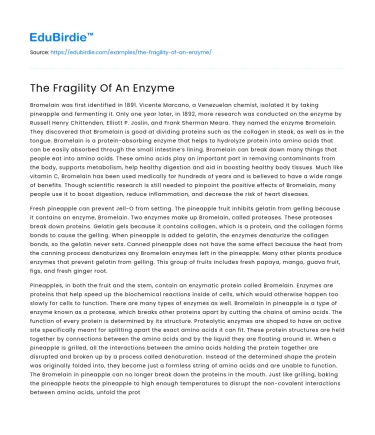Bromelain was first identified in 1891. Vicente Marcano, a Venezuelan chemist, isolated it by taking pineapple and fermenting it. Only one year later, in 1892, more research was conducted on the enzyme by Russell Henry Chittenden, Elliott P. Joslin, and Frank Sherman Meara. They named the enzyme Bromelain. They discovered that Bromelain is good at dividing proteins such as the collagen in steak, as well as in the tongue. Bromelain is a protein-absorbing enzyme that helps to hydrolyze protein into amino acids that can be easily absorbed through the small intestine’s lining. Bromelain can break down many things that people eat into amino acids. These amino acids play an important part in removing contaminants from the body, supports metabolism, help healthy digestion and aid in boosting healthy body tissues. Much like vitamin C, Bromelain has been used medically for hundreds of years and is believed to have a wide range of benefits. Though scientific research is still needed to pinpoint the positive effects of Bromelain, many people use it to boost digestion, reduce inflammation, and decrease the risk of heart diseases.
Fresh pineapple can prevent Jell-O from setting. The pineapple fruit inhibits gelatin from gelling because it contains an enzyme, Bromelain. Two enzymes make up Bromelain, called proteases. These proteases break down proteins. Gelatin gels because it contains collagen, which is a protein, and the collagen forms bonds to cause the gelling. When pineapple is added to gelatin, the enzymes denaturize the collagen bonds, so the gelatin never sets. Canned pineapple does not have the same effect because the heat from the canning process denaturizes any Bromelain enzymes left in the pineapple. Many other plants produce enzymes that prevent gelatin from gelling. This group of fruits includes fresh papaya, mango, guava fruit, figs, and fresh ginger root.
Save your time!
We can take care of your essay
- Proper editing and formatting
- Free revision, title page, and bibliography
- Flexible prices and money-back guarantee
Pineapples, in both the fruit and the stem, contain an enzymatic protein called Bromelain. Enzymes are proteins that help speed up the biochemical reactions inside of cells, which would otherwise happen too slowly for cells to function. There are many types of enzymes as well. Bromelain in pineapple is a type of enzyme known as a protease, which breaks other proteins apart by cutting the chains of amino acids. The function of every protein is determined by its structure. Proteolytic enzymes are shaped to have an active site specifically meant for splitting apart the exact amino acids it can fit. These protein structures are held together by connections between the amino acids and by the liquid they are floating around in. When a pineapple is grilled, all the interactions between the amino acids holding the protein together are disrupted and broken up by a process called denaturation. Instead of the determined shape the protein was originally folded into, they become just a formless string of amino acids and are unable to function. The Bromelain in pineapple can no longer break down the proteins in the mouth. Just like grilling, baking the pineapple heats the pineapple to high enough temperatures to disrupt the non-covalent interactions between amino acids, unfold the protein, and denature the structure.
While the tongue can regenerate the cells on the tongue, a slice of meat does not have that ability. Bromelain can denaturize the collagen proteins that make the meat tough, so it is an effective tenderizer. Many powdered meat tenderizers contain an extracted enzyme (such as Bromelain) as one of the active ingredients.
Bromelain is an effective enzyme used to tenderize meat, stop the gelling process in Jell-O, and stopping other processes. As with most enzymes, this enzyme is rather fragile, as it can be denatured by heating or boiling it. It is so fragile that even food processing can denaturize the Bromelain in the food. Because they are so fragile, they break down almost as soon as they are formed.






 Stuck on your essay?
Stuck on your essay?

